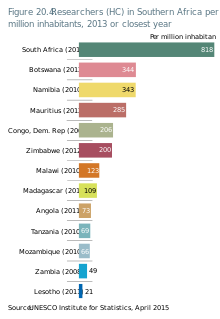ටැන්සානියාවේ විද්යාව සහ තාක්ෂණය

ටැන්සානියාවේ පළමු "ජාතික විද්යා හා තාක්ෂණ ප්රතිපත්තිය" 1996 දී සම්මත කරන ලදී. රජයේ "දැක්ම 2025" (1998) ලේඛනයේ පරමාර්ථය වූයේ "ආර්ථිකය විද්යාවෙන් හා තාක්ෂණයෙන් පීඩාවට පත් වූ ශක්තිමත්, ඔරොත්තු දෙන සහ තරඟකාරී එකක් බවට පරිවර්තනය කිරීම" ය.
එක් එක්සත් ජාතීන්ගේ මුලපිරීමේ කුඩය යටතේ, යුනෙස්කෝ සහ ටැන්සානියානු රජයේ දෙපාර්තමේන්තු සහ ආයතන "ජාතික විද්යා හා තාක්ෂණ ප්රතිපත්තිය" සංශෝධනය කිරීම සඳහා 2008 දී යෝජනා මාලාවක් සකස් කරන ලදී. ඇමරිකානු ඩොලර් මිලියන 10 ක සම්පූර්ණ ප්රතිසංස්කරණ අයවැයට අරමුදල් සපයන ලද්දේ One UN අරමුදල සහ වෙනත් මූලාශ්රවලින්. යුනෙස්කෝව සංචාරක ක්ෂේත්රය ඇතුළුව ප්රධාන භූමිය සහ සැන්සිබාර් සඳහා ම්කුකුටා II සහ ම්කුසා II සඳහා නව "ජාතික වර්ධනය සහ දරිද්රතාවය අවම කිරීමේ උපාය මාර්ගය" වෙත විද්යාව, තාක්ෂණය සහ නවෝත්පාදන ප්රධාන ප්රවාහය සඳහා සහාය ලබා දුන්නේය.[තහවුරු කර නොමැත]
ටැන්සානියාවේ සංශෝධිත විද්යා ප්රතිපත්තිය 2010 දී ප්රකාශයට පත් කරන ලදී. "ජාතික පර්යේෂණ සහ සංවර්ධන ප්රතිපත්තිය" යන මාතෘකාවෙන් යුත් එය පර්යේෂණ හැකියාවන්හි ප්රමුඛතා ක්රියාවලිය වැඩිදියුණු කිරීමේ අවශ්යතාවය හඳුනා ගනී සම්පත්. ජාතික පර්යේෂණ අරමුදලක් පිහිටුවීම සඳහා ද ප්රතිපාදන සලසා ඇත. මෙම ප්රතිපත්තිය 2012 සහ 2013 දී සමාලෝචනය කරන ලදී.[1]

2010 දී ටැන්සානියාව පර්යේෂණ හා සංවර්ධනය සඳහා දළ දේශීය නිෂ්පාදිතයෙන් සියයට 0.38ක් කැප කළේය. 2013 වසරේ ගෝලීය සාමාන්යය දළ දේශීය නිෂ්පාදිතයෙන් සියයට 1.7 කි. 2010 දී ටැන්සානියාවේ ජනගහනය මිලියනයකට පර්යේෂකයන් 69 ක් (ප්රධාන සංඛ්යාවෙන්) සිටියහ. 2014 දී ටැන්සානියාව, තොම්සන් රොයිටර්ස් වෙබ් ඔෆ් සයන්ස් (විද්යා උපුටා දැක්වීම් දර්ශක විස්තීරණ) අනුව, ජාත්යන්තරව ලැයිස්තුගත කර ඇති සඟරාවල වැසියන් මිලියනයකට ප්රකාශන 15 ක් ගණන් කළේය. උප-සහාරා අප්රිකාව සඳහා සාමාන්යය වැසියන් මිලියනයකට ප්රකාශන 20 ක් වූ අතර ගෝලීය සාමාන්ය ජනගහනය මිලියනයකට ප්රකාශන 176 කි. ටැන්සානියාව 2023 දී ගෝලීය නවෝත්පාදන දර්ශකයේ 113 වන ස්ථානය දක්වා පහත වැටුණු අතර එය 2019 හි 97 වන ස්ථානය විය.[2][3][4]
යොමු කිරීම්
[සංස්කරණය]- ^ Kraemer-Mbula, Erika; Scerri, Mario (2015). Southern Africa. In: UNESCO Science Report: towards 2030 (PDF). Paris: UNESCO. pp. 535–565. ISBN 978-92-3-100129-1. 10 ඔක්තෝබර් 2017 දින මුල් පිටපත (PDF) වෙතින් සංරක්ෂණය කරන ලදී.
- ^ WIPO (12 December 2023). Global Innovation Index 2023, 15th Edition (ඉංග්රීසි බසින්). World Intellectual Property Organization. doi:10.34667/tind.46596. ISBN 9789280534320. සම්ප්රවේශය 2023-10-30.
{{cite book}}:|website=ignored (help) - ^ "Global Innovation Index 2019". www.wipo.int (ඉංග්රීසි බසින්). සම්ප්රවේශය 2021-09-02.
- ^ "Global Innovation Index". INSEAD Knowledge (ඉංග්රීසි බසින්). 2013-10-28. 2 September 2021 දින මුල් පිටපත වෙතින් සංරක්ෂණය කරන ලදී. සම්ප්රවේශය 2021-09-02.
